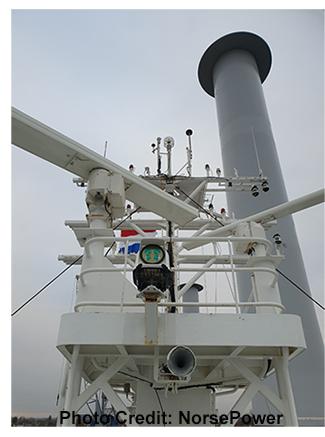How Vaisala’s wind sensing technology helps to propel sustainable shipping operations
The maritime shipping industry is at a crucial juncture in its quest to reduce greenhouse gas (GHG) emissions. As highlighted in a recent white paper by the International Windship Association (IWSA), wind propulsion technologies offer a promising pathway to achieve significant emissions reductions (access white paper here). Vaisala’s advanced wind sensors and wind lidar technologies are uniquely positioned to support this transition, offering unparalleled accuracy and reliability in monitoring and managing wind resources.
The potential of wind propulsion
Wind propulsion is emerging as a pivotal solution in the maritime shipping sector's decarbonization strategy. According to the IWSA white paper, integrating wind propulsion systems can lead to a reduction in fuel consumption and GHG emissions by 20-47% across the fleet by 2030 (SAFETY4SEA). These systems, which include wind-assist and primary wind propulsion technologies, are becoming increasingly viable for a wide range of vessels, from tankers to bulk carriers and even cruise ships.
Future projections are promising. Based on the white paper, the EU forecasts up to 10,700 installed wind propulsion systems by 2030, saving up to 7.5 million tonnes of CO2 and creating around 20,000 jobs. The UK Clean Maritime Plan projects the market to grow to £2 billion annually by the 2050s, with 37,000-40,000 ships equipped with wind propulsion — as much as 45% of the global fleet.
As of August 2023, there were 30 large wind propulsion-equipped vessels in operation, with 16 more installations pending by early 2024. An IWSA survey from June 2023 shows strong industry support for wind propulsion, recognizing its significant potential in reducing emissions and achieving regulatory compliance.
Overall, wind propulsion offers a scalable, economically viable solution to significantly reduce the maritime shipping industry's carbon footprint.
Enhancing wind propulsion with Vaisala technology
Our suite of wind sensors and wind lidars is ideal for optimizing the use of wind propulsion systems. Here’s how these technologies contribute to sustainable shipping operations.

- Accurate wind monitoring
- Ultrasonic wind anemometers provide accurate measurements of wind speed and direction, crucial for effective sail management and optimization of wind-assisted propulsion systems. This accuracy helps with better system optimization and further fuel efficiency.
- Note: Using wind sensors for navigation differs significantly from their use in ship propulsion and energy generation. The precision and methods for wind measurement must be at a different level when applied to propulsion
- Advanced Lidar technology

- Vaisala WindCube® wind lidar offers detailed spatial distribution data of undisturbed wind fields, which is essential for understanding wind effects from ship superstructure, wakes, and other environmental factors. Undisturbed wind data supports the optimal deployment of wind propulsion systems, helps in performance validation, and ensures maximum energy capture and efficiency (SAFETY4SEA).
Case studies and market adoption
The adoption of wind propulsion technologies is gaining momentum. For instance, the Northern Lights project, a collaboration involving major oil companies, utilizes Norsepower Rotor Sails alongside LNG dual-fuel engines to significantly cut CO₂ emissions. Such projects exemplify the potential of combining wind propulsion with other green technologies (SAFETY4SEA).
Norsepower has significantly improved the performance of its Rotor Sails using WindCube Nacelle horizontal profiling wind lidar. This advanced technology provides precise and reliable wind data, optimizing the Rotor Sails' performance. This collaboration has demonstrated fuel savings ranging from 5% to 25%, showcasing substantial environmental benefits and cost savings for maritime operations. For more details, see our Norsepower case study.
Econowind enhances sustainability in maritime shipping by integrating wind propulsion systems. Their VentiFoils® units capture wind energy efficiently, reducing fuel consumption and emissions. Collaborating with MARIN, they optimize deployment using WindCube Scan scanning lidar. As ship owners adopt wind propulsion, the industry moves toward greener practices.
Another key example is the use of Vaisala's remote wind monitoring solutions to enhance wind-assisted propulsion. By deploying Vaisala wind lidars, detailed and undisturbed wind field data is collected, which is crucial for optimizing the performance of wind propulsion systems. This data aids in effective sail management, performance validation, and ensures maximum energy capture and efficiency. These technologies have been successfully integrated into various vessels, demonstrating significant improvements in operational efficiency and environmental impact reduction. For more details, see our remote wind monitoring case study.
In another example, various ship owners and operators, including Mitsui O.S.K. Lines and CMA-CGM, are actively integrating wind propulsion systems into their fleets, driven by the dual benefits of cost savings and regulatory compliance (SAFETY4SEA).
Towards more sustainable shipping
As the maritime industry strives to meet ambitious decarbonization targets set by the IMO and other regulatory bodies, the integration of advanced wind propulsion systems, supported by cutting-edge technologies, is critical. Vaisala’s wind sensors and wind lidars not only enhance the performance and efficiency of these systems but also play a vital role in promoting.
Learn more about how Vaisala’s wind sensors and wind lidars can support your shipping operations on our website.


